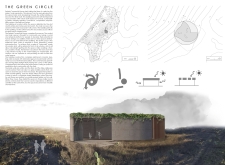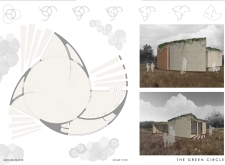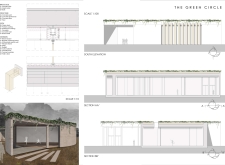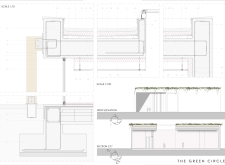5 key facts about this project
At its core, The Green Circle serves as a multifunctional space designed to accommodate a variety of community activities. The circular layout promotes inclusivity and encourages movement throughout the building. This spatial organization not only facilitates engagement but also ensures a seamless transition between different areas, which can be easily adapted for various events and gatherings. The emphasis on flexibility within the design reflects a modern understanding of how spaces can serve a multitude of purposes, providing users with the opportunity to both connect and reflect.
The architectural design features a central circular structure characterized by flowing lines and organic forms, which evoke a sense of continuity and growth. This design approach is further emphasized by the choice of materials, which includes reinforced concrete, gypsum board, wood, and glass. The use of reinforced concrete offers durability and structural stability, while the exposed aggregate finish provides a tactile quality that resonates with the surrounding environment. The internal finishes utilize gypsum board for a clean and elegant aesthetic, enhancing the overall lightness of the interior space.
Wood is incorporated not only for its warmth but also as an important design element that fosters an inviting atmosphere. Meanwhile, expansive glass panels are strategically placed to create a connection with the outdoors, allowing natural light to flood the interior while visually linking users to the surrounding landscape. This transparency not only blurs the lines between inside and outside but also reinforces the concept of openness that is crucial to the project's ethos.
The design also pays close attention to sustainability. By orienting the building to maximize solar access, the architects ensure that energy consumption is minimized. The integration of green elements—such as living roofs and vertical gardens—provides additional thermal insulation and enhances biodiversity. This attention to eco-friendly practices and renewable resources is a vital aspect of the project's identity, illustrating how architecture can positively impact both the environment and the community.
Additionally, the layout encourages social interaction through communal spaces. These areas are designed to be adaptable, allowing for the occupation of different user groups throughout the day. This adaptability extends to movable partitions, enabling spaces to change configuration based on needs. The ability to host workshops, community meetings, or informal gatherings illustrates the project's commitment to fostering a sense of community.
The design represents a unique architectural approach that embraces local context while ensuring a comprehensive understanding of user needs. It embodies a user-oriented philosophy, allowing individuals to connect with themselves and with one another within a thoughtfully designed environment. The attention to detail in both the exterior and interior elements reflects a careful consideration of how architecture can influence human behavior and social interactions.
Overall, The Green Circle stands as an example of architecture that prioritizes functionality and ecological responsibility while fostering a sense of community. For those interested in exploring the diverse elements of this project more deeply, including architectural plans, sections, designs, and ideas, reviewing the comprehensive project presentation will offer valuable insights and further illustrate the underlying principles that guided its development.


























